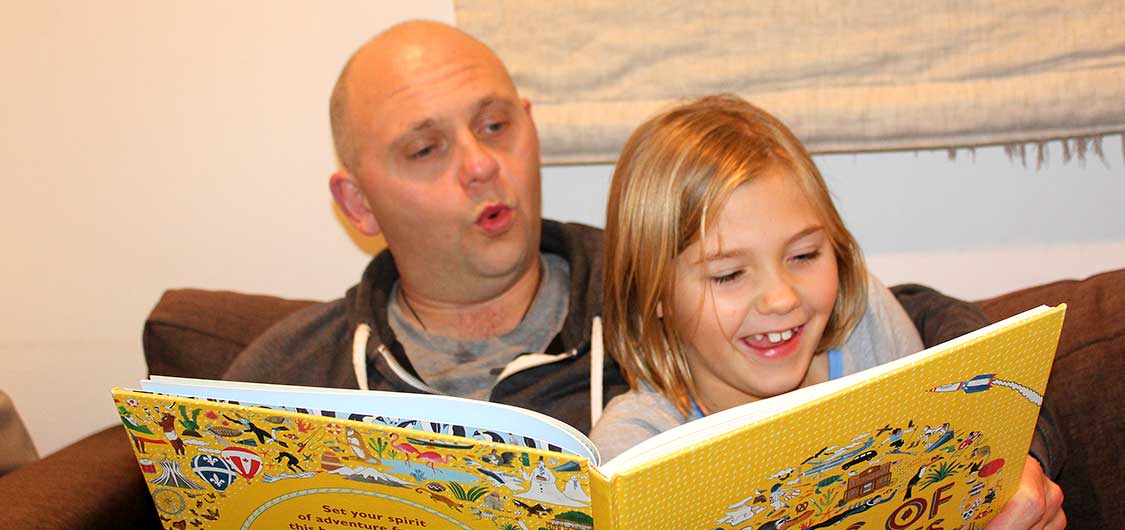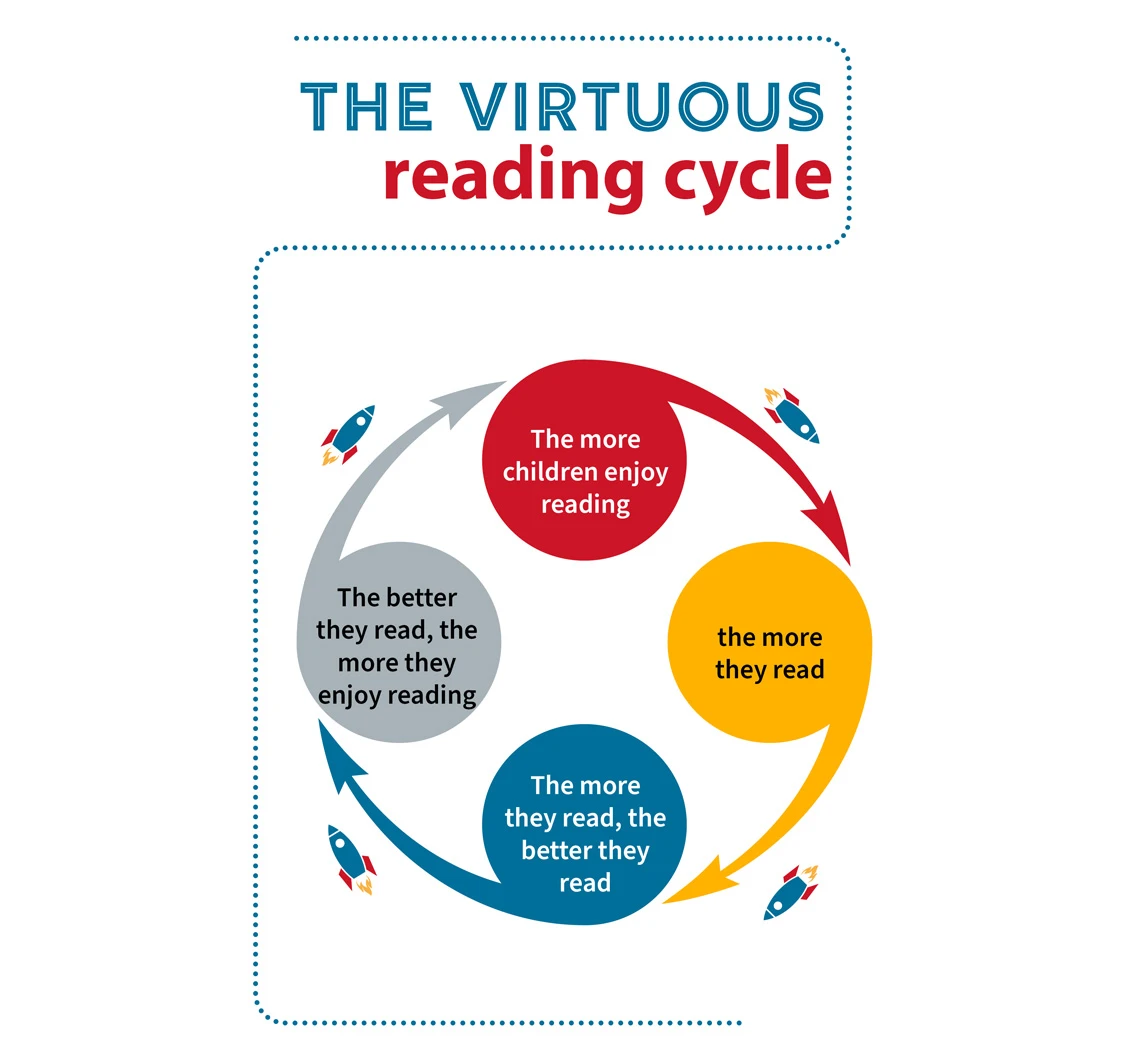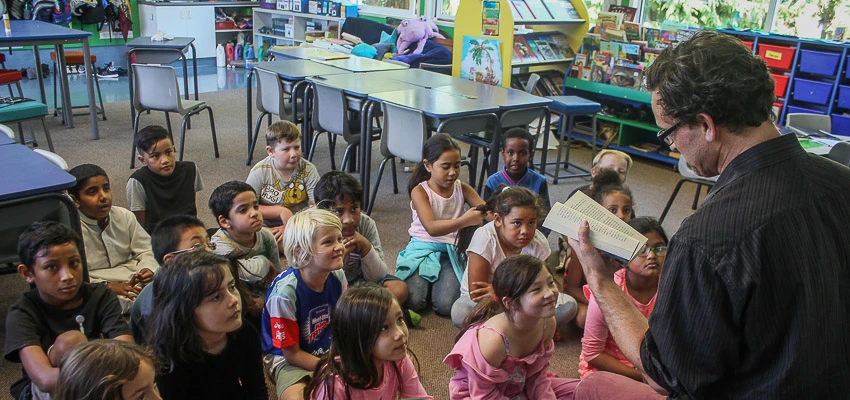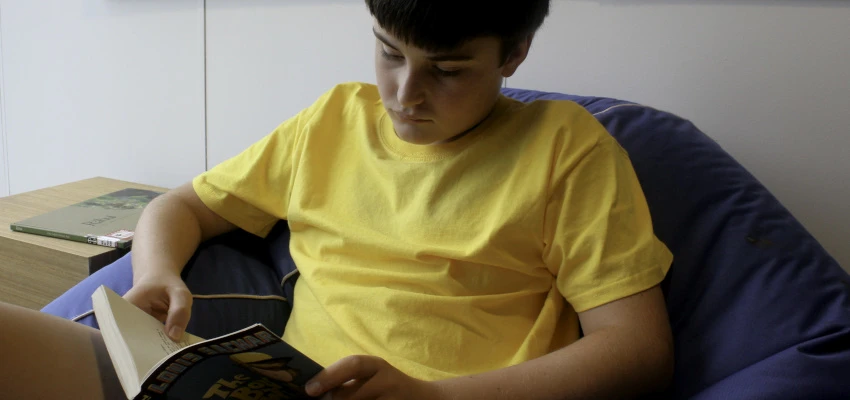
Reading at home
Find out how you can support and encourage your children and teenagers to read for pleasure. This is one of the most powerful ways of improving their literacy, learning and wellbeing.
Support your child to become a reader
Reading develops literacy, knowledge, social skills and empathy, and supports wellbeing. When children are encouraged and able to read for pleasure, they are likely to read more often.
Children familiar with books and stories before they start school are better prepared for formal literacy teaching.
Books contain new words to help build your child's language and understanding.
Reading together and chatting about books, stories and pictures in books is fun and helps build relationships.
Supporting your child to read for pleasure at home can make a big difference to their lives. This is equally as important for teens.

The virtuous reading cycle published in the Services to Schools brochure ‘Help your child become a reader’ — Reading at home.
As children move from learning to read to reading to learn and develop independent reading skills, the support and encouragement for reading often become less of a focus. Researcher and lecturer, Margaret Merga, calls this ‘expired expectations’ and ‘orphaned responsibilities’.
Reading engagement for tweens and teens: What would make them read more?
Reading for pleasure — a door to success
Reading for wellbeing (hauora)
Tips to foster a love of reading
Create a reading culture at home. Children and teens read more when they:
are read to — even when they can read themselves
see adults around them reading as part of their everyday lives
have access to a plentiful and varied selection of resources.
Reading to and with your child matters. A little bit and often can make a big difference. Encourage your child to read books and other things in print or online that they enjoy.
Start reading books with children as soon as possible. This helps prepare them for school.
Let them choose books to read — they'll enjoy them more.
It’s okay to read a book again and again and again.
Make time. 10–15 minutes every day can make a big difference.
Visit the public library together.
Be a reading role model and let them see you read.
Make time, place and routines for reading
Make reading a regular part of home life. The National Literacy Trust UK recommends daily story time.
Set aside time to switch off distractions for a few minutes and give your full attention to a shared experience. This shared reading not only nurtures children's interest in reading and stories but also your relationship.
Reading a story should be a fabulous, wonderful thing. The most important thing that parents can do for kids is to read with them and to let their kids see them reading books for their own pleasure.
— Kate DiCamillo, Insights beyond the Meet-the-Author movie
The magic of sharing stories at home (YouTube video, 2:20) — BookTrust, 2023.
Fun activities to explore when reading at home
Try acting out parts of a story, perform scenes from plays, use storytelling puppets.
Help your child retell their version of a story.
Attend events at your school and public library. For example, attend book clubs, poetry readings, Book Week, language weeks, holiday programmes.
Play games that encourage sharing parts of some favourite children's or YA books. For example, you could give clues, explain the plot in 10 words, or ask yes/no questions to guess the book. Challenge each other to find the worst book villain or the best opening lines.
Try STEM/STEAM activities that combine reading with aspects of science, technology, engineering, arts and maths.
Other ideas include:
Story boxes: A hands-on literacy experience — Norma Drissel shares ideas for story boxes. Includes picture book suggestions and objects to use.
NZCYA Book Awards activity booklet — download the activity booklet or other resources provided by the New Zealand Book Awards for Children and Young Adults.
How to make puppets — 6 ideas using everyday materials to make puppets.
STEAM — School Library Journal and Amy Koester's Pinterest include ideas, activities, experiments and reading suggestions for projects.
Read aloud
Reading aloud to your child regularly will help them become great readers and listeners.
Reading aloud enables your child to experience books too difficult for them to read themselves. As they become better readers and start reading independently, they will still enjoy you reading to them.
When you read to your child, you are saying:
I love you
I value my time with you
I love reading and think it is important.
The single most important activity for building the knowledge required for eventual success in reading is reading aloud to children.
— Richard C. Anderson, Becoming a nation of readers: The report of the Commission on Reading
Chat about the story and share other stories. Keep reading and story time together enjoyable and relaxed with no work attached.
Reading aloud — explore research and tips for reading aloud as well as downloadable brochures in a range of languages.
Talk with staff at your child's school
Speak with their teacher and school library staff about how best to help your child build a love for reading. Sharing and reinforcing similar messages about the importance of reading at school and at home can be powerful.
Discuss your child’s reading, learning abilities and interests.
Discuss your child’s cultural identity and home language.
Tell them about any reading experiences and activities that take place in your home and community.
Share success stories about your child's reading.
Ask for tips for reading aloud, book recommendations and other ways you can support your child.
Be a reading role model
Children learn by watching the adults around them. Parents and whānau are vital reading role models for children. For boys, seeing dads and other males reading is especially important. Here are some things you can do:
Let your children see you reading. When you show that you value and enjoy reading as part of your everyday life, reading will become part of their lives too.
Explain to your child why reading for pleasure is important and enjoyable.
Include members of your wider whānau. Reading with grandchildren can be a special time for grandparents and creates close bonds between the generations.
Use video-calling tools to share books at a distance.
Talk about favourite authors, genres and series.
Identify ‘read-alikes’ and other similar titles your child may enjoy.
Books and Reads — for kids and teens — a collection of websites to help you find children's and young adult (YA) books with reviews, recommendations and reading communities.
Chat about books
Talking about books helps children become readers too. Chat about what you are reading with your children and share favourites from your childhood:
Look at books and talk about the pictures.
Point out interesting details in the illustrations.
Predict or wonder what will happen next.
Talk about what you’ve just read and share feelings about the book.
Talk about how you choose books, how long you give them and why you give up on some.
Share your own family’s stories and encourage them to tell them to you too
Talk about the reading we do all through the day — signs, recipes and instructions.
The Ministry of Education has tips on helping your child learn at home:
The importance of talking, reading, drawing, counting — early learning.
Ideas to help with reading, writing and maths — primary school.
Helping your child develop key competencies — secondary school.
Let children choose books
One of the best ways to encourage your children to read is to give them plenty of reading materials to choose from and time to browse and read.
Keep it light and easy.
Don’t underestimate the value of comics, magazines or graphic novels.
When a child hooks into a favourite series and reads them all, their reading mileage soars.
Light reading often leads to heavier reading once the reading habit is formed. We all read in different ways and Daniel Pennac’s ‘Reader's Bill of Rights’ is a good message for all readers — young and old. The 10 rights are:
The right to not read
The right to skip pages
The right to not finish
The right to reread
The right to read anything
The right to escapism
The right to read anywhere
The right to browse
The right to read out loud
The right to not defend your tastes.
Help your child figure out his or her interests by asking these questions:
If a book were written just for you, what would it be about?
If you could be an expert on any subject, what would it be?
What are two things you are really curious about?
— Amy Friedman, 6 ways to create a love for reading
Have things to read at home
Children and teens read more when they are surrounded by books and other high-interest reading material.
Borrowing books and other resources
There are lots of options for borrowing books instead of buying them.
Discuss with your child's teacher or school library staff your options for borrowing resources through the school. For example:
read-aloud chapter books for bedtime reading
books in your home language and inclusive reading material — print, multimedia and digital.
Use your public library. Explore the range of resources, for example, books, large print books, eAudios, eBooks, eMagazines, eNewspapers and musical CDs.
Groups that can support you — Ministry of Education — list of groups that provide library resources and digital collections for children with special education learning needs.
Build your home library
Some ways you can build your home library include:
borrowing books from your school or public library
swapping books, comics and magazines with other families and at little libraries like Lilliput Libraries
giving books or book vouchers for birthdays and Christmas
buying second-hand books from shops or online
getting games and puzzles that require your child to read and follow instructions
using everyday materials such as cookbooks, cereal boxes, websites, television adverts, road signs, billboards and logos to encourage everyday reading.
eAudios can be another great addition to your library — Get set to listen to some great books this summer!
Lilliput Libraries — find Lilliput Libraries in your area.
Keep children and tweens reading, including over the summer
Teens and tweens face many screen-based distractions (social media, gaming and television). School, friendships and sport means there is little time left for them to spend reading.
It's more important than ever to support and encourage reading for pleasure. This has significant educational benefits, enhances wellbeing and builds empathy.
Tween readers — keeping them motivated
Read over summer and the holidays
Read to your child and support them to continue reading for pleasure and writing over the school holidays. This helps prevent the ‘summer slide’ — when children lose some of their reading gains over the long summer break.
Many school and public libraries will run summer reading challenges that you could encourage your child to engage with.
Research on the summer slide and summer reading
Free reading resources, National Library brochures
New Zealand resources
Books and Reads for kids and teens — use our Books and Reads tool to explore, find and share children and young adult (YA) books and reviews.
Goodnight Kiwi — celebrity storytellers read New Zealand bedtime stories.
Kiwi Kids News — latest news items and current events about New Zealand and overseas, selected for students and teachers.
NZ writers read — New Zealand Society of Authors' playlist of authors reading from their work (#NZWritersRead).
Pasifika dual language resources — books to support Pasifika new entrant students in English-medium classrooms. Many books are available as PDFs and all are available as MP3 audio files.
Poetry Box — Paula Green’s poetry site is full of poems by and for children.
Storytime — Radio New Zealand provides a collection of New Zealand audio stories for children and teens.
Storytime — NZSO — well-known New Zealand people reading storytime classics accompanied by the New Zealand Symphony Orchestra.
The Māori Gods series — YouTube videos created by KIWA Digital voiced in te reo Māori and English.
ToiToi TV — showcases videos of kids reading kids’ stories and poems.
International
Free audio books — Open Culture's curation of free eAudios includes many children’s classics.
Free eBooks — Open Culture's curation of free eBooks includes many children's classics.
Marvel comics — download the app to read comics online.
Storyline Online — the SAG-AFTRA Foundation’s children’s literacy website streams videos featuring actors reading children’s books alongside creatively produced illustrations.
The Graveyard Book — YouTube videos of Neil Gaiman reading aloud chapters 1–8 of his book.
Unite for Literacy — eBooks (fiction and non-fiction) in English and a variety of other languages for emerging readers.
National Library reading brochures
Read our brochures for tips for reading with your children and helping them to become readers.
Help your child become a reader — English (pdf, 1.4 MB)
Āwhinatia tō tamaiti kia ako ki te pānui — te reo Māori (pdf, 1.4 MB)
Fehoahoani ki tau tamaiti ke kavea ma tino faitau — Tokelauan (pdf, 263 KB)
Fesoasoani i lau tama ia avea o se faitautusi — Samoan (pdf, 274 KB)
Help your child become a reader — Arabic (pdf, 274 KB)
Help your child become a reader — Hindi (pdf, 282 KB)
Help your child become a reader — simplified Chinese (474 KB)
Lagomatai e tama haau ke eke mo tagata totou — Niuean (pdf, 264 KB)
Tauturu‘ia ta‘au tamaiti 'akariro'ia koe ei tangata tatau — Cook Island Māori (pdf, 261 KB)
Tokoni‘i ‘a ho‘o tamá hoko ko ha tokotaha manako laukonga — Tongan (pdf, 279 KB)
Related content

Reading aloud
Reading aloud to children and teenagers is enjoyable and stimulates interest, imagination and a love of reading. Finding and choosing a ‘read-aloud’ that you and your students will enjoy is crucial. Explore our other tips and resources.
Engaging teens with reading
Teenagers' lives are increasingly digital. Reading for pleasure, especially long-form reading, competes with the compelling lure of social media, games and schoolwork for teen's time. Find inspiration and strategies to encourage teens to read for pleasure.Image credit: All rights reserved.